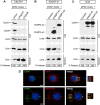Alix regulates egress of hepatitis B virus naked capsid particles in an ESCRT-independent manner
- PMID: 21129143
- PMCID: PMC7162389
- DOI: 10.1111/j.1462-5822.2010.01557.x
Alix regulates egress of hepatitis B virus naked capsid particles in an ESCRT-independent manner
Abstract
Hepatitis B virus (HBV) is an enveloped DNA virus that exploits the endosomal sorting complexes required for transport (ESCRT) pathway for budding. In addition to infectious particles, HBV-replicating cells release non-enveloped (nucleo)capsids, but their functional implication and pathways of release are unclear. Here, we focused on the molecular mechanisms and found that the sole expression of the HBV core protein is sufficient for capsid release. Unexpectedly, released capsids are devoid of a detectable membrane bilayer, implicating a non-vesicular exocytosis process. Unlike virions, naked capsid budding does not require the ESCRT machinery. Rather, we identified Alix, a multifunctional protein with key roles in membrane biology, as a regulator of capsid budding. Ectopic overexpression of Alix enhanced capsid egress, while its depletion inhibited capsid release. Notably, the loss of Alix did not impair HBV production, furthermore indicating that virions and capsids use diverse export routes. By mapping of Alix domains responsible for its capsid release-mediating activity, its Bro1 domain was found to be required and sufficient. Alix binds to core via its Bro1 domain and retained its activity even if its ESCRT-III binding site is disrupted. Together, the boomerang-shaped Bro1 domain of Alix appears to escort capsids without ESCRT.
© 2010 Blackwell Publishing Ltd.
Figures








References
-
- Beterams, G. , and Nassal, M. (2001) Significant interference with hepatitis B virus replication by a core–nuclease fusion protein. J Biol Chem 276: 8875–8883. - PubMed
-
- Bishop, N. , and Woodman, P. (2001) TSG101/mammalian VPS23 and mammalian VPS28 interact directly and are recruited to VPS4‐induced endosomes. J Biol Chem 276: 11735–11742. - PubMed
Publication types
MeSH terms
Substances
LinkOut - more resources
Full Text Sources
Research Materials
Miscellaneous

